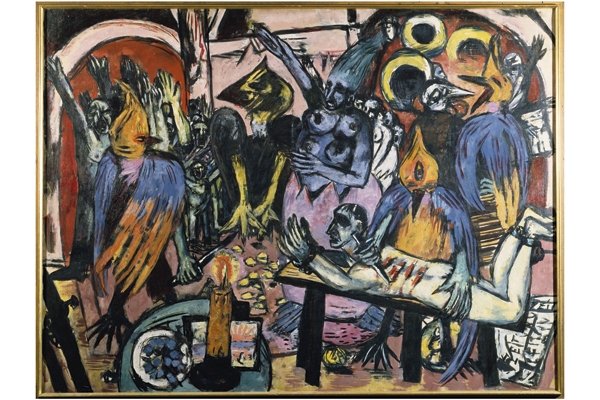Curated by the Louvre as a tribute to mark the 50th anniversary of the Franco–German co-operation treaty signed in January 1963, De l’Allemagne 1800–1939: German thought and painting from Friedrich to Beckmann sounds like a harmless survey of German art. But it is stranger than that, less a measured look at German painting and more a very French attempt to interrogate the German soul, Nietzsche’s writings in hand.
The exhibition opens dramatically with eight 12ft-high canvases by Anselm Kiefer. They were made especially for the show and provide the exhibition’s title, in turn taken from Madame de Staël’s famous book De l’Allemagne. Collaged with dramatic woodcuts and painted inscriptions — ‘Melancholia’, ‘der Rein’, ‘Vater, h. Geist, Sohn, Satan’, ‘Atlantic Wall’ — Kiefer’s portentous, doomy ensemble gets a room to itself. So, too, does Tischbein’s marvellous portrait of ‘Goethe in the Roman Campagna’ showing the great man on leave from the Weimar court, delighting in nature and the antique.
Alarm bells begin to ring in the first section of the show where an introductory storyboard argues for two strains in 19th- and early-20th-century German art and culture, the Apollonian (rational and classical) and the Dionysian (dark, illogical, cruel). The first rooms offer Apollo in the form of a fine group of narrative paintings by the Nazarenes and their circle and by later artists such as Johann Anton Ramboux and Adrian Ludwig Richter. Theirs was a romanticism that drew variously upon Greek temple structures, the pure colours of early Italian art, Dürer’s precise draughtsmanship, medieval German architecture and folk tales being noted down by the Brothers Grimm. All these paintings have a luminous charm.
The Dionysian section that follows, with paintings such as Franz von Stuck’s nastily neo-primitive ‘Fight for a Woman’ (1905) and Arnold Böcklin’s weird, late ‘Nereids at Play’ (1886), makes a suitably striking contrast. But does such work epitomise a strand of German-ness — the dark side? After all, von Stuck and Böcklin’s febrile imagery was hardly specific to German art at that date. One has only to turn to Edvard Munch or to the Polish Jacek Malczewski’s surreal confections to realise that Dionysus held sway all over Europe just before and after 1900.
The second part of the show, ‘L’Hypothèse de la Nature’, is also given a binary treatment, with Goethe’s colour theories and nature studies set against the visionary landscape paintings of Caspar David Friedrich and Karl Gustav Carus. There are 17 very fine paintings by Friedrich. In a much less familiar section, chronology is abandoned and intriguing comparisons are drawn between the plant and mineral studies of Goethe and of Paul Klee. Philipp Otto Runge’s attempts at a symbolic cosmology using arabesques and floral symmetry inspired by the mystical writings of Jacob Böhme are ranged opposite Carl Wilhelm Kolbe’s etchings of fantastical trees and gardens. ‘L’Hypothèse de la Nature’ ends with a group of neo-Romantic landscapes full of melancholy foreboding painted in the 1930s by Otto Dix, George Grosz and Franz Radziwill.
The final part of the exhibition, ‘Ecce Homo’, concentrates on artists’ reactions to the first world war. An unnerving selection of photographs by August Sander dominates, alongside suites of prints by Max Beckmann and Otto Dix that meditate on the horrors of conflict. The mood of ‘Ecce Homo’ is grim and monochrome. Strangely, key interwar groups such as Die Brücke and Der Blaue Reiter are excluded as are the design and architecture achievements of the Bauhaus — on the grounds that De l’Allemagne is not a survey show. There is no sculpture but some film, including, controversially, Leni Riefenstahl’s propaganda masterpiece Olympia (1936), shown opposite Siodmak and Ulmer’s playful, hedonistic Menschen auf Sonntag (1930).
The exhibition has provoked fiercely hostile articles in the Frankfurter Allgemeine Zeitung and the weekly Die Zeit. Both argue that De l’Allemagne presents Germany as programmed for war and catastrophe, making the culture of National Socialism appear inevitable. One of the key German scholars involved in the exhibition, Andreas Beyer, director of the German Forum for Art History in Paris, has criticised the deterministic slant of the show. The Germans have a point. Although De l’Allemagne does not seriously engage with the art of the Third Reich, despite its cut-off date of 1939, the Apollo–Dionysius binary that floats up all through the exhibition is unfortunate. But despite its dubious intellectual framework, the high quality of the work included means that De l‘Allemagne is not an exhibition to miss.






Comments